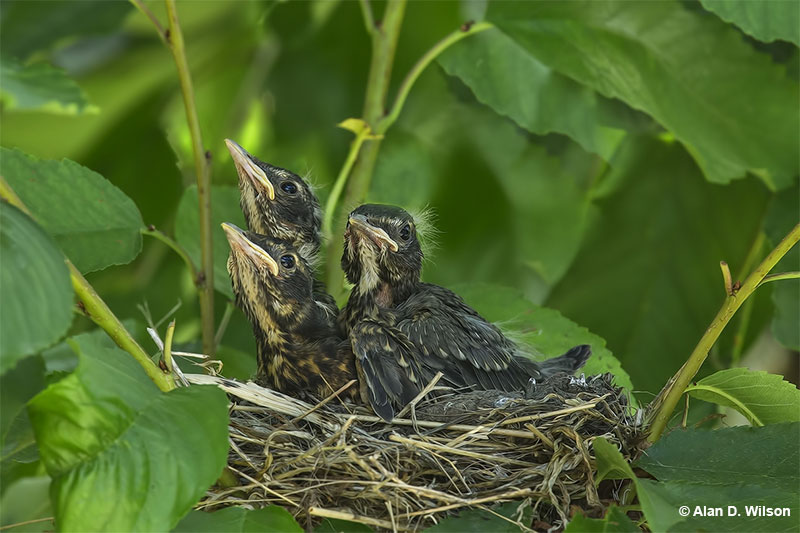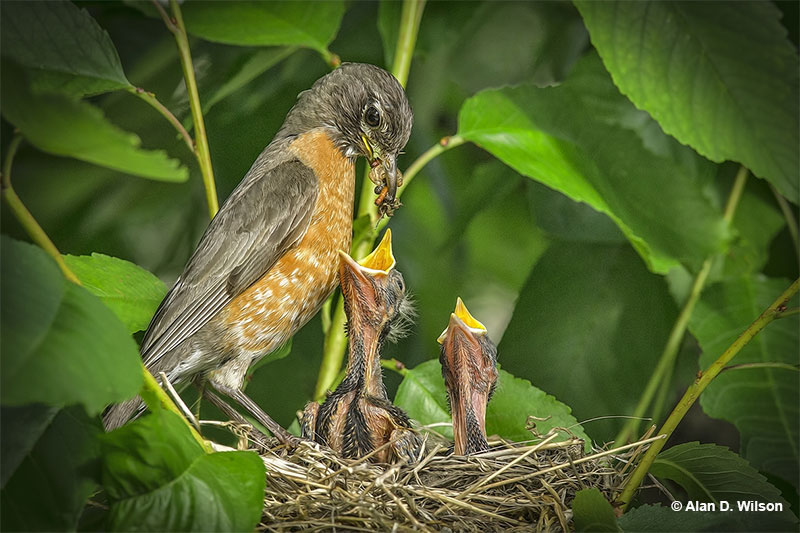
The American Robin is a common but striking songbird found throughout North America. These birds are known for their vividly orange-red chest and cheerful songs – a familiar sound in parks, gardens, and forests across the continent.
They all start their lives as baby robins – they hatch from the eggs and grow into adults we love observing and listening to.
How does the American Robin life journey begin? How do the young robins look like, and how do their parents raise them?
Same as many young birds, baby robins are called chicks. Immediately after emerging from their eggs, they are known as hatchlings. Until they are ready to fledge, they are known as nestlings. When they are ready to leave the nest or fledge, we call them (you would have never guessed it!) fledglings.
On this page
The Nest
Like with most other North American birds, the breeding season for Robins begins in early spring, usually lasting from April into the summer.
At the beginning of the season, the male establishes a territory and begins courting the females.
When a pair is formed, the female starts building the cup-shaped nest with some help from the male. The materials used in nest-building are grasses, twigs, and hair, secured by soft mud from worm castings in the end to create a sturdy and heavy nest.
When the nest is all done, the female lays a clutch of 3 to 5 sky-blue or greenish-blue eggs with no other markings. There are two and sometimes three broods per season.
The female lays on the eggs, incubating them for 12 to 14 days. The male’s task is to feed the female while she’s incubating.
Keep reading: Robin nest & eggs (ID guide + stages)
Robin chicks are altricial – meaning they are born blind, naked, and barely mobile. They’re helpless and completely dependent on their parents for food and protection. All they can do is plead for their parents to feed them.

© Alan D. Wilson
Luckily, the chicks grow rapidly, largely due to their high-protein insect and arthropod diet. The diet is dominated by various larvae and other available insects. Both parents feed the young, with the female being a bit more diligent feeder.
The robin chicks will be covered in downy feathers within a week and leave the nest within 14-16 days from hatching.
American Robin parents are very dedicated and fiercely defend the nest and the chicks from intruders and predators such as squirrels and snakes.
What Does A Baby Robin Look Like?
Baby robins look like typical songbird chicks – almost naked with pinkish skin and only the sparse white fluffy down covering it. Their eyes are round and fully closed, and the small hatchling beaks are yellow.
As days pass, the new feathers grow, grey-brown in color; the eyes start to open by day five and are fully open by day eight.
Older nestlings have dark brown feathers with light streaks and spots, as well as cream-colored throats with two parallel brown lines.
Newly hatched babies weigh only 6.6 grams on average. In only two weeks, at the time of fledging, they’ll be more than eight times heavier, weighing around 56 grams.
The fledglings have similar colors to adults – only a bit duller and with brown spots across the dull-orange breast.
How To Tell Baby Robins Apart?
Hatchling robins would be difficult to tell apart from other songbird hatchlings, at least early in their development. The best chance of confirming that it really is a Robin baby is to see the nest and the recognizable adults around it.
More mature nestlings have a grey-brown overall color with occasional cream, yellowish, or even orange spots and streaks.
The heads have a distinct pattern. The base color is brown to dark grey, with cream-white “brows” (streak over each eye) and throat. The light-colored throat has two dark brown lines running from the mouth’s edges that merge with the brown color on the spotted chest.
As in adults, the beaks of baby robins are yellow throughout their development.
What Do Baby Robins Eat?
Baby American Robins eat insects and other arthropods brought to the nest by adults. The parents hunt for insects that are most available at the moment and as nutritious as possible.
Larvae, and especially caterpillars such as cutworms, are among the favorites.
Related: What do baby birds eat?
Seasonally abundant insects such as craneflies (Tipulidae) are also commonly on the menu, and parents sometimes manage to catch two or three breeding pairs of these flies in one effort.
Frequently Asked Questions
What do you call robin babies?
You can use typical songbird common nouns for baby robins. The most general name is “baby robin chicks,” with additional names depending on the developmental stage.
Right after hatching, baby robins are called “hatchlings.” During the days they’re nest-bound, we call them “nestlings.” When they begin to leave the nest, they’re known as “fledglings.”
How long does it take a fledgling robin to learn to fly?
Fledglings leave the nest in about 13 days, but most won’t be able to fly right away. It will take them another week or two to master this skill; in the meantime, you can often observe them hopping on the ground.
What do you do if you find an abandoned baby robin?
If you find an abandoned baby robin, try to locate the nest and put the nestlings back in there. If that’s impossible, contact your nearest bird protection society or a wildlife rescue center for further instructions.
While it’s possible to raise baby robins on your own, this is definitely not recommended. Birds raised by anyone other than a licensed wildlife rescuer have a very poor survival rate in the wild because of the imprinting phenomenon and the lack of parental survival skill lessons.
If baby robins you found are already fledglings, it is best to leave them alone because they’re not abandoned. They’re just learning to fend for themselves. On the other hand, you can pay attention to your cat and alert your neighbors to try and keep their cats inside until the robins learn to fly and leave.
What color are baby robins?
Hatchlings are naked and pink, covered only with white, fluffy down. Older fledglings display a predominantly grey-brown hue with intermittent spots and streaks in shades of cream, yellow, and orange.
The heads have a distinct pattern dominated by dark brown-grey and accented by cream-white “brows” above each eye and over the throat, as well as small light spots. The light throat has two dark brown lines running from the mouth’s edges that meet with the brown marking on the chest, again adorned with spots. The beak is yellow.
